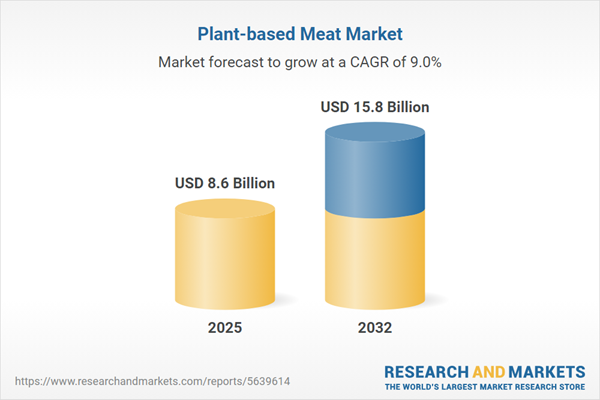Speak directly to the analyst to clarify any post sales queries you may have.
Senior executives navigating the plant-based meat market must prioritize agility and innovation to capture shifting consumer preferences and adapt to regulatory and operational demands. As competition intensifies across global markets, proactive leadership and informed decision-making are essential for sustained business alignment and growth.
Market Snapshot of the Plant-Based Meat Market
From 2024 to 2032, the plant-based meat market is projected to nearly double, with revenues expected to rise from USD 7.93 billion to USD 15.80 billion and a compound annual growth rate (CAGR) of 8.99%. This trajectory is being driven by increasing consumer appetite for alternative proteins and ongoing advancements in production capabilities. Industry frontrunners are pursuing product innovation and refining go-to-market strategies that encompass retail, foodservice, and institutional sectors. Enhanced logistics are key as businesses position themselves to react swiftly to regulatory shifts and fluctuating demand, strengthening both their competitiveness and operational resilience.
Scope & Segmentation Coverage
- Source Materials: Key ingredients like pea, soy, and wheat form the cornerstone for consistent quality and compliance, enabling adaptation to diverse consumer profiles and regulatory expectations worldwide.
- Product Types: A wide spectrum of offerings—including burgers, cutlets, sausages, and nuggets—supports varied use across retail shelves and foodservice solutions, broadening channels for market entry and user adoption models.
- Plant-Based Protein Types: Alternatives that replicate beef, chicken, fish, and pork equip brands to develop broad product portfolios and address differentiated dietary and cultural needs.
- Storage Formats: Options such as frozen, refrigerated, and shelf-stable cater to supply chain flexibility, help manage inventory, and accommodate evolving consumer shopping and consumption habits.
- End Users: HORECA (hotels, restaurants, catering) and household consumers constitute the core segments, each influencing distinct nutritional innovation and targeted marketing approaches.
- Distribution Channels: The combination of digital and physical channels allows brands to respond to local market dynamics, extend geographic reach, and ensure access to changing buying behaviors.
- Key Regions: Presence in the Americas, Europe, Middle East, Africa, and Asia-Pacific necessitates thoughtful compliance strategies and localization to meet diverse regulatory and adoption landscapes.
- Leading Companies: Firms such as Basic American Foods, Beyond Meat, Charoen Pokphand Foods, The Kellogg Company, Impossible Foods, Conagra Brands, Maple Leaf Foods, Ingredion, Tata Consumer Products, and The Tofurky Company are at the forefront, setting standards, and fueling continued category innovation.
- Key Technologies: The deployment of precision fermentation, advanced extrusion, and improved formulations is enhancing production scalability, consistency, and speed-to-market for plant-based meat producers.
Key Takeaways for Senior Decision-Makers
- Integrate health and sustainability initiatives across business operations to reinforce corporate values and proactively meet shifting regulatory demands.
- Form strategic alliances with biotechnology partners to drive continuous innovation and ensure readiness for nutritional and safety standard changes.
- Widen omnichannel distribution networks by leveraging digital advances, expanding market presence as supply chain complexities grow.
- Focus on local sourcing and regional operations to create agile supply chains capable of weathering global disruptions and evolving market trends.
- Adapt product offerings and marketing strategies to localized consumer needs, facilitating entry into new markets and expansion in underpenetrated segments.
- Direct investment toward scalable infrastructure and automation, underlining efficient market entry while supporting consistency in multi-channel operations.
Assessing Tariff Impact on Plant-Based Meat Supply Chains
Recent changes in U.S. tariff policy are prompting industry leaders to reassess how costs and supply lines are managed. Expanding supplier networks, increasing domestic sourcing, and investing in improved logistics help build supply chain transparency and enable organizations to respond quickly to market shifts. These practices collectively boost resilience against price changes and minimize supply risks.
Methodology & Data Sources
This analysis is based on a comprehensive review of trade publications, official government sources, and peer-reviewed academic material. Insights from executive interviews and direct supply chain assessments provide additional context, with consumer trend monitoring ensuring relevance for executive strategies.
Why This Report Matters
- Provides actionable insights to inform procurement, product development, and compliance approaches in the evolving plant-based meat sector.
- Highlights operational and technological best practices, supporting competitive positioning and long-term advantage for organizations.
- Offers strategies to help leaders adjust swiftly to regulatory and market changes, promoting business resilience and adaptability.
Conclusion
Sustained success in the plant-based meat landscape depends on leading innovation, adapting to regional shifts, and building meaningful partnerships. Agility and collaboration are key drivers for organizational relevance and continued market strength.
Additional Product Information:
- Purchase of this report includes 1 year online access with quarterly updates.
- This report can be updated on request. Please contact our Customer Experience team using the Ask a Question widget on our website.
Table of Contents
3. Executive Summary
4. Market Overview
7. Cumulative Impact of Artificial Intelligence 2025
Companies Mentioned
The companies profiled in this Plant-based Meat market report include:- Basic American Foods
- Beyond Meat, Inc.
- Charoen Pokphand Foods PLC
- Co-operative Group Limited
- Conagra Brands, Inc.
- Deliciou Pty Ltd.
- FoodEase
- Hindustan Unilever Limited
- Imagine Meats Platform
- Impossible Foods Inc.
- Imposter Meat Official
- Ingredion Incorporated
- Livekindly Company, Inc.
- Maple Leaf Foods Inc.
- MisterVeg Foods Pvt Ltd.
- Next Meats Holdings, Inc.
- Redefine Meat Ltd.
- Tata Consumer Products Limited
- The Hain Celestial Group, Inc.
- The Kellogg Company
- The Mighty Food
- The Tofurky Company, Inc.
- VBites Foods Ltd.
- Vezlay Foods Pvt. Ltd.
- Wakao Foods
Table Information
| Report Attribute | Details |
|---|---|
| No. of Pages | 191 |
| Published | November 2025 |
| Forecast Period | 2025 - 2032 |
| Estimated Market Value ( USD | $ 8.6 Billion |
| Forecasted Market Value ( USD | $ 15.8 Billion |
| Compound Annual Growth Rate | 8.9% |
| Regions Covered | Global |
| No. of Companies Mentioned | 26 |









